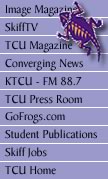|
Photo Illustrations by Erin LaMourie/FEATURES EDITOR and Eric Elton/SKIFF STAFF
Comparing Plans Average
cost of meal plans each semester Cost
for a cheesburger, fries and 20 oz. fountain drink *plans allow an unlimited amount of food for meal price |
Flexing
Dining Dollars It’s not everyday that parents tell their children to spend money. But
that’s exactly what freshman pre-major Betsy Cunningham heard
from her mother when she realized she might have trouble spending
the minimum amount on her dining plan. “(The current program) is bothersome because it is hard to keep up with how much you have or haven’t spent,” Cunningham said. Schools such as TCU ascribe to an a la carte plan for which students pay a set amount of money and can then use it to purchase whatever they want, whenever they want. “It gives students flexibility,” said TCU Dining Services Marketing Manager Legia Abato, “You have a choice of where and how you are going to spend the money.” Richard Flores, general manager of dining services, said TCU has used the a la carte program since at least 1980 when Sodexho Marriott Services took over dining services. The a la carte plan is more versatile than the block plan because it lets students spend the money at a number of places, Cunningham said. “I like the a la carte system better because I like that we can charge detergent and stuff,” said freshman psychology major Crystal Poulton.
“When you get a certain amount of meals a week, if you don’t eat them then they’re just lost,” Poulton said. “But with a la carte, if I eat less on campus this week, I can eat more on campus next week.” Schools such as Baylor University, Southern Methodist University and University of Texas at Arlington have found a new solution to the block versus a la carte debate and have chosen to combine the plans. State schools such as UTA require students to purchase the traditional block plan but have added an a la carte option for flexibility. Harlan Wood, assistant business director at UTA, said students purchase a certain amount of money that can be used in the all-you-can-eat dining halls and then purchase “flex dollars” which can be used for fast food on campus. SMU has a similar plan which combines block plans with a declining balance account. SMU students who live on campus and are not seniors must purchase a “lifestyle plan” in which students choose a block plan and a certain number of “flex dollars” to be used at on-campus fast food franchises, said SMU Food Service Director Ed Devoid. “We have two kinds of dining plans — unlimited access, which is like a floating balance, and residential dining block, (for) which students purchase a set number of meals,” said Devoid. Devoid said lifestyle plans work because the students who stay on-campus to eat can purchase larger dining blocks, and the students who prefer to eat off-campus can purchase smaller plans. Baylor takes this versatility a step further by adding a floating balance along with block and a la carte plans. “Each meal plan at Baylor has three aspects - a block plan for the food court, a declining balance for the fast food franchises and a guest pass which is a floating balance to be used by guests or by the student at any time,” said Jerry Finch, district manager of Aramark food services at Baylor. The current program at Baylor went into effect for the fall 2001 semester, Finch said. “The changes were student-driven,” Finch said. “We decided to change after meeting with students and student groups who requested a declining balance and floating meals as well as a block plan.” Unlike students at Baylor, Cunningham said TCU students seem to be less concerned with the dining plan structure as they are with the cost. It is a big concern that the money not used up in spring is lost, she said. “For boys it wasn’t enough money, and for girls it was too much money,” Poulton said. “I had to buy a lot of random things at the end of the semester to try to get my account down.” Abato said the price of the dining plan is chosen to make sure freshmen have enough to eat, and the price for upperclassmen is chosen to help pay for university fees. “It’s a safeguard for parents,” Abato said. “They want to be sure the money is going to food and not other things.” Jessica
Sanders |
|
|
TCU Daily Skiff © 2002 |
||




 “Though
the food is more expensive, you can spread out your money.”
“Though
the food is more expensive, you can spread out your money.”